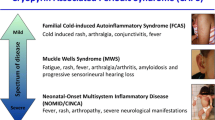Abstract
Background
Neonatal onset multisystem inflammatory disease (NOMID), an autoinflammatory disease, is characterized by fever, chronic urticarial rash, CNS manifestations, and arthropathy. Approximately 50% of patients with NOMID have de novo missense mutations in CIAS1, which is associated with modulation of the IL-1b and apoptotic pathways. Approximately 60% of NOMID patients have prominent arthropathy, most commonly involving the knees, the cause of which remains poorly understood.
Objective
To more fully describe the findings of NOMID arthropathy on MRI and radiography and to provide a better understanding of the origin of the bony lesions.
Materials and methods
We imaged 20 patients with NOMID to further investigate NOMID-associated bony lesions.
Results
Bony abnormalities were seen in the knees of 11/20 patients. The knee findings included enlarged, deformed femora and patellae in all and tibiae in the majority, without evidence of synovitis. Some patients had other joint involvement. Most had short stature and valgus or varus knee deformities. No association was noted between bony abnormalities and CIAS1 mutations. The abnormalities appeared to be the result of a mass-producing process. The resulting heterogeneously calcified masses appeared to originate in the physis and deformed the adjacent metaphysis and epiphysis.
Conclusion
These findings suggest that the arthropathy of NOMID is the result of abnormal endochondral bone growth. Further investigation is needed to determine whether this deformity is triggered by inflammation early in development or by CIAS1 mutations causing abnormal chondrocyte apoptosis.




Similar content being viewed by others
References
Lorber J (1973) Syndrome for diagnosis: dwarfing, persistently open fontanelle; recurrent meningitis; recurrent subdural effusions with temporary alternate-sided hemiplegia; high-tone deafness; visual defect with pseudopapilloedema; slowing intellectual development; recurrent acute polyarthritis; erythema marginatum, splenomegaly and iron-resistant hypochromic anaemia. Proc R Soc Med 66:1070–1071
Prieur AM (2001) A recently recognised chronic inflammatory disease of early onset characterised by the triad of rash, central nervous system involvement and arthropathy. Clin Exp Rheumatol 19:103–106
Hull KM, Shoham N, Chae JJ et al (2003) The expanding spectrum of systemic autoinflammatory disorders and their rheumatic manifestations. Curr Opin Rheumatol 15:61–69
Leone V, Presani G, Perticarari S et al (2003) Chronic infantile neurological cutaneous articular syndrome: CD10 over-expression in neutrophils is a possible key to the pathogenesis of the disease. Eur J Pediatr 162:669–673
Stojanov S, Kastner DL (2005) Familial autoinflammatory diseases: genetics, pathogenesis and treatment. Curr Opin Rheumatol 17:586–599
Aksentijevich I, Nowak M, Mallah M et al (2002) De novo CIAS1 mutations, cytokine activation, and evidence for genetic heterogeneity in patients with neonatal-onset multisystem inflammatory disease (NOMID): a new member of the expanding family of pyrin-associated autoinflammatory diseases. Arthritis Rheum 46:3340–3348
Feldmann J, Prieur AM, Quartier P et al (2002) Chronic infantile neurological cutaneous and articular syndrome is caused by mutations in CIAS1, a gene highly expressed in polymorphonuclear cells and chondrocytes. Am J Hum Genet 7:198–203
Hoffman HM, Mueller JL, Broide DH et al (2001) Mutation of a new gene encoding a putative pyrin-like protein causes familial cold autoinflammatory syndrome and Muckle-Wells syndrome. Nat Genet 29:301–305
Torbiak RP, Dent PB, Cockshott WP (1989) NOMID – a neonatal syndrome of multisystem inflammation. Skeletal Radiol 18:359–364
Kaufman RA, Lovell DJ (1986) Infantile-onset multisystem inflammatory disease: radiologic findings. Radiology 160:741–746
DeCunto C, Liberatore D, San Roman J et al (1997) Infantile-onset multisystem inflammatory disease: a differential diagnosis of systemic juvenile rheumatoid arthritis. J Pediatr 130:513–515
Ballock RT, O’Keefe RJ (2003) Physiology and pathophysiology of the growth plate. Birth Defects Res C Embryo Today 69:123–143
Masumoto J, Dowds TA, Schaner P et al (2003) ASC is an activating adaptor for NF-kappa B and caspase-8-dependent apoptosis. Biochem Biophys Res Commun 303:69–73
Dowds TA, Masumoto J, Zhu L et al (2004) Cryopyrin-induced interleukin 1beta secretion in monocytic cells: enhanced activity of disease-associated mutants and requirement for ASC. J Biol Chem 279:21924–21928
Yarom A, Rennebohm RM, Levinson JE (1985) Infantile multisystem inflammatory disease: a specific syndrome? J Pediatr 106:390–396
Shumate ML, Yumet G, Ahmed TA et al (2005) Interleukin-1 inhibits the induction of insulin-like growth factor-I by growth hormone in CWSV-1 hepatocytes. Am J Physiol Gastrointest Liver Physiol 289:G227–G239
Martensson K, Chrysis D, Savendahl L (2004) Interleukin-1beta and TNF-alpha act in synergy to inhibit longitudinal growth in fetal rat metatarsal bones. J Bone Miner Res 19:1805–1812
Dinarello CA (1991) Interleukin-1 and interleukin-1 antagonism. Blood 77:1627–1652
Hashkes PJ, Lovell DJ (1997) Recognition of infantile-onset multisystem inflammatory disease as a unique entity. J Pediatr 130:513–515
Frenkel J, Wulffraat NM, Kuis W (2004) Anakinra in mutation-negative NOMID/CINCA syndrome: comment on the articles by Hawkins et al and Hoffman and Patel. Arthritis Rheum 50:3738–3739; author reply 3739–3740
Lovell DJ, Bowyer SL, Solinger AM (2005) Interleukin-1 blockade by anakinra improves clinical symptoms in patients with neonatal-onset multisystem inflammatory disease. Arthritis Rheum 52:1283–1286
Author information
Authors and Affiliations
Corresponding author
Rights and permissions
About this article
Cite this article
Hill, S.C., Namde, M., Dwyer, A. et al. Arthropathy of neonatal onset multisystem inflammatory disease (NOMID/CINCA). Pediatr Radiol 37, 145–152 (2007). https://doi.org/10.1007/s00247-006-0358-0
Received:
Revised:
Accepted:
Published:
Issue Date:
DOI: https://doi.org/10.1007/s00247-006-0358-0




